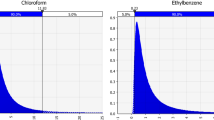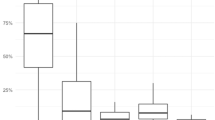Abstract
The objective of this investigation was to determine the extent of areal and day-to-day variability of stationary environmental tobacco smoke (ETS) concentrations in a single large facility where smoking was both prevalent and unrestricted, and to determine the degree of daily variation in the personal exposure levels of ETS constituents in the same facility. The subject facility was a relatively new four-story office building with an approximate volume of 1.3 million ft3. The exchange of outside air in the building was determined to be between 0.6 and 0.7 air changes per hour. Eighty-seven area samples (excluding background) were collected at 29 locations over the course of 6 days of sampling. Locations included offices and cubicles occupied by smokers and nonsmokers, common areas, and the computer and mail rooms. Twenty-four nonsmoking subjects wore personal sampling systems to collect breathing zone air samples on each of 3 days in succession. This generated a total of seventy-two 8-h time-weighted average (TWA) personal exposure samples. In all samples, respirable suspended particulate matter, ultraviolet light-absorbing and fluorescing particulate matter, solanesol, nicotine, and 3-ethenyl pyridine were determined. With the exception of a few locations, tobacco-specific airborne constituents were determined in all samples. Not surprisingly, areas with the highest ETS constituent concentrations were offices and cubicles of smokers. Median and 95th percentile concentrations for all area samples, excluding background, were determined to be 1.5 and 8.7 μg/m3 for nicotine, and 8.2 and 59 μg/m3 for ETS-specific particles (as solanesol-related particulate matter, Sol-PM), respectively. Personal exposure concentrations of ETS components were similar to those levels found in the area samples (median nicotine and Sol-PM concentrations were 1.24 and 7.1 μg/m3, respectively), but the range of concentrations was somewhat smaller. For example, the 95th percentile 8-h TWA nicotine and ETS-specific particle (as Sol-PM) concentrations were 3.58 and 21.9 μg/m3, respectively. Intrasubject variation of daily concentrations ranged from 20% to 60%, depending on the component. Self-reported proximity to smokers was supported by higher ETS concentrations determined from the personal monitors, but only to a modest extent. Although smoking was completely unrestricted inside the main office areas of the facility, ETS levels, either areal or from personal exposure measurements, were lower than those estimated by Occupational Safety and Health Administration to be present in such facilities.
This is a preview of subscription content, access via your institution
Access options
Subscribe to this journal
Receive 6 print issues and online access
$259.00 per year
only $43.17 per issue
Buy this article
- Purchase on Springer Link
- Instant access to full article PDF
Prices may be subject to local taxes which are calculated during checkout




Similar content being viewed by others
Abbreviations
- CO2:
-
carbon dioxide
- ETS:
-
environmental tobacco smoke
- FPM:
-
fluorescing particulate matter
- HPLC:
-
high-performance liquid chromatograph
- OSHA:
-
Occupational Safety and Health Administration
- RSP:
-
respirable suspended particulate matter
- Sol-PM:
-
solanesol-related particulate matter
- TWA:
-
time-weighted average
- UVPM:
-
ultraviolet light-absorbing particulate matter.
References
Baek, S. O., Kim, U. S. and Perry, R. Indoor air quality in homes, offices, and restaurants in Korean urban areas — indoor/outdoor relationships. Atmos Environ. (1997) 31: 529–544.
Centers for Disease Control and Prevention, US Department of Health and Human Services. State laws on tobacco control — United States, 1998. CDC Surveill Summ. (1999) 48(3) (SS-4803): 21–40.
Centers for Disease Control and Prevention, US Department of Health and Human Services. State-specific prevalence of current cigarette smoking among adults and the proportion of adults who work in a smoke-free environment — United States, 1999. Morb Mortal Wkly Rep. (2000) 49(43): 978–982.
Conner, J. M., Oldaker, G. B. III, and Murphy, J. J. Method for assessing the contribution of environmental tobacco smoke to respirable suspended particles in indoor environments. Environ Technol. (1990) 11: 189–196.
Daisey, J. M., Mahanama, K. R. R. and Hodgson, A. T. Toxic volatile organic compounds in simulated environmental tobacco smoke: emission factors for exposure assessment. J Expos Anal Environ Epidemiol. (1998) 8: 313–334.
Funk, L. M., Sedman, R., Beals, J. A. and Fountain, R. Quantifying the distribution of inhalation exposure in human populations: 2. Distributions of time spent by adults, adolescents, and children at home, at work, and at school. Risk Anal. (1998) 18(1): 47–56.
Hammond, S. K., Sorensen, G., Youngstrom, R. and Ockene, J. K. Occupational exposure to environmental tobacco smoke. J Am Med Assoc. (1995) 274: 956–960.
Heavner, D. L., Morgan, W. T. and Ogden, M. W. Determination of volatile organic compounds and respirable suspended particulate matter in New Jersey and Pennsylvania homes and workplaces. Environ Int. (1996) 22: 159–183.
Hedge, A., Erickson, W. A. and Rubin, G. The effects of alternative smoking policies on indoor air quality in 27 smoking office buildings. Ann Occup Hyg. (1994) 38: 265–278.
Jenkins, P. L., Phillips, T. J., Mulberg, E. J. and Hui, S. P. Activity patterns of Californians: use and proximity to indoor pollutant sources. Atmos Environ. (1992) 26A(12): 2141–2148.
Jenkins, R. A., Palausky, A., Counts, R. W., Bayne, C. K., Dindal, A. B. and Guerin, M. R. Exposure to environmental tobacco smoke in sixteen cities in the United States as determined by personal breathing zone sampling. J Expos Anal Environ Epidemiol. (1996) 6(4): 473–502.
Jenkins, R. A., Guerin, M. R. and Tomkins, B. A. The Chemistry of Environmental Tobacco Smoke: Composition and Measurement, 2nd ed. Lewis Publishers, Boca Raton, FL. 2000, 467 pp.
Lakind, J. S., Ginevan, M. E., Naiman, D. Q., James, A. C., Jenkins, R. A., Dourson, M. L., Felter, S. P., Graves, C. G. and Tardiff, R. G. Distribution of exposure concentrations and doses for constituents of environmental tobacco smoke. Risk Anal. (1999) 19(3): 375–390.
Martin, P., Heavner, D. L., Nelson, P. R., Maiolo, K. C., Risner, C. H., Simmons, P. S., Morgan, W. T. and Ogden, M. W. Environmental tobacco smoke (ETS): a market cigarette study. Environ Int. (1997) 23: 75–90.
Maskarinec, M. P., Jenkins, R. A., Counts, R. W. and Dindal, A. B. Determination of exposure to environmental tobacco smoke in restaurant and tavern workers in one US city. J Expos Anal Environ Epidemiol. (2000) 10: 36–49.
Nelson, P. R., Heavner, D. L., Collie, B. B., Maiolo, K. C. and Ogden, M. W. Effect of ventilation and sampling time on environmental tobacco smoke component ratios. Environ Sci Technol. (1992) 26: 1909–1915.
Nelson, P. R., Kelly, S. P., Conrad, F. W., Richardson, J. D., Maiolo, K. C. and Risner, C. H. Generation of ETS by cigars: a follow-up study. Presented at the 53rd Tobacco Science Research Conference, Montreal, Quebec, Canada, September 12–15, 1999.
Ogden, M. W. Use of capillary chromatography in the analysis of environmental tobacco smoke. Capillary Chromatography — The Applications, 1st ed., Chap. 5. Huthig, Heidelberg, Germany. 1991.
Ogden, M. W. Occupational exposure to environmental tobacco smoke. JAMA, J Am Med Assoc. (1996) 275: 441
Ogden, M. W. Methods of analysis for nicotine, 3-ethenyl pyridine, respirable suspended particles (RSP), ultraviolet particulate matter (UVPM), fluorescent particulate matter (FPM), and solanesol in environmental tobacco smoke (ETS) collaborative study. Presented at the 114th AOAC International Annual Meeting, Philadelphia, PA, September 10–14, 2000.
Ogden, M. W. and Jenkins, R. A. Nicotine in environmental tobacco smoke. In: Gorrod J.W. and Jacob P. III (Eds.), Analytical Determination of Nicotine and Related Compounds and their Metabolites Elsevier, Amsterdam. 1999.
Ogden, M. W. and Maiolo, K. C. Comparison of GC and LC for determining solanesol in environmental tobacco smoke. LC-GC. (1992) 10: 459–462.
Ogden, M. W. and Richardson, J. D. Effect of lighting and storage conditions on the stability of ultraviolet particulate matter, fluorescent particulate matter, and solanesol. Tob Sci. (1998) 42: 10–15.
Ogden, M. W., Maiolo, K. C., Oldaker, G. B. III, and Conrad, F. W. Evaluation of methods for estimating the contribution of ETS to respirable suspended particles. Indoor Air '90, Proc 5th Int Conf Indoor Air Qual Clim. (1990) 2: 425–420 Toronto, Ontario, Canada, July 29–August 3
Ogden, M. W., Heavner, D. L., Foster, T. L. L., Maiolo, K. C., Cash, S. L., Richardson, J. D., Martin, P., Simmons, P. S., Conrad, F. W. and Nelson, P. R. Personal monitoring system for measuring environmental tobacco smoke exposure. Environ Technol. (1996) 17: 239–250.
Oldaker, G. B., Perfetti, P. F., Conrad, F. C. Jr. Conner, J. M. and McBride, R. L. Results of surveys of environmental tobacco smoke in offices and restaurants. Int Arch Occup Environ Health. (1990) 99–104.
Oldaker, G. B., Taylor, W. D. and Parrish, K. B. Investigations of ventilation rate, smoking activity and indoor air quality at four large office buildings. Environ Technol. (1995) 16: 173–180.
Pamuk, E., Makuc, D., Heck, K., Reuben, C., and Lochner, K. Socioeconomic Status and Health Chartbook. Health, United States, 1998. National Center for Health Statistics, Hyattsville, MD. 1998.
Phillips, K., Bentley, M. C., Howard, D. A. and Alvan, G. Assessment of air quality in Stockholm by personal monitoring of nonsmokers for respirable suspended particles and environmental tobacco smoke. Scan J Work Environ Health. (1996) 22: 1–24.
Phillips, K., Bentley, M. C., Howard, D. A., Alvan, G. and Huici, A. Assessment of air quality in Barcelona by personal monitoring of nonsmokers for respirable suspended particles and environmental tobacco smoke. Environ Int. (1997) 23: 173–196.
Phillips, K., Bentley, M., Howard, D., and Alvan, G. Assessment of environmental tobacco smoke and respirable suspended particle exposures for nonsmokers in Prague using personal monitoring. Int Arch Occup Environ Health. (1998) 71: 379–390.
Redhead, C. S. and Rowberg, R. E. Environmental tobacco smoke and lung cancer risk. CRS Report to Congress, Congressional Research Service, Library of Congress November 14, 1995 75 pp.
Sterling, E. M., Collett, C. W. and Ross, J. A. Assessment of non-smokers' exposure to environmental tobacco smoke using personal-exposure and fixed-location monitoring. Indoor Built Environ. (1996) 5: 112–125.
Turner, S., Cyr, L., and Gross, A. J. The measurement of environmental tobacco smoke in 585 office environments. Environ Int. (1992) 18: 19–28.
US Department of Labor, Occupational Safety and Health Administration, Proposed rule. Fed Regist. (1994, April 5) 59(65): 15969–16039.
Vaughan, W. M. and Hammond, S. K. Impact of “designated smoking area” policy on nicotine vapor and particle concentrations in a modern office building. J Air Waste Manage Assoc. (1990) 40: 1012–1017.
Whitmyre, G. K., Driver, J. H., Ginevan, M. E., Tardiff, R. G. and Baker, S. R. Human exposure assessment: I. Understanding the uncertainties. Toxicol Ind Health. (1992) 8(5): 297–320.
Acknowledgements
This research was sponsored by the Center for Indoor Air Research, Linthicum, MD, under contract no. ERD-88-812 with the Oak Ridge National Laboratory, managed by UT-Battelle, LLC for the US Department of Energy, under contract no. DE-AC05-00OR22725.
Author information
Authors and Affiliations
Corresponding author
Rights and permissions
About this article
Cite this article
JENKINS, R., MASKARINEC, M., COUNTS, R. et al. Environmental tobacco smoke in an unrestricted smoking workplace: area and personal exposure monitoring. J Expo Sci Environ Epidemiol 11, 369–380 (2001). https://doi.org/10.1038/sj.jea.7500178
Received:
Published:
Issue Date:
DOI: https://doi.org/10.1038/sj.jea.7500178
Keywords
This article is cited by
-
Modeling geographic and demographic variability in residential concentrations of environmental tobacco smoke using national data sets
Journal of Exposure Science & Environmental Epidemiology (2011)



